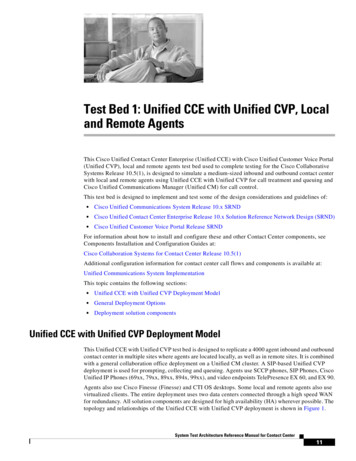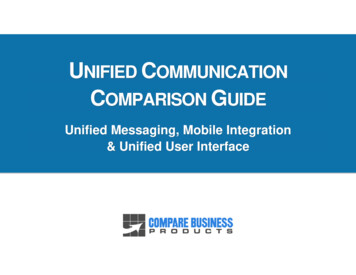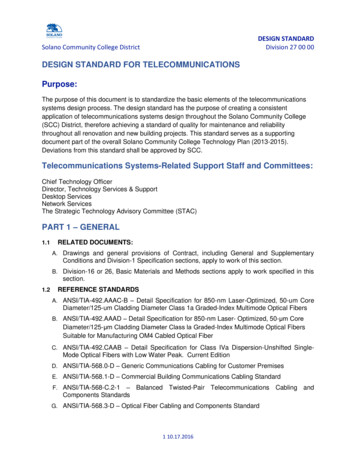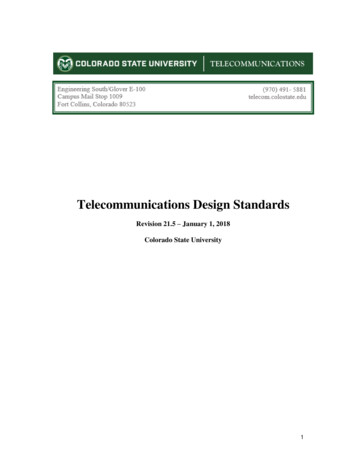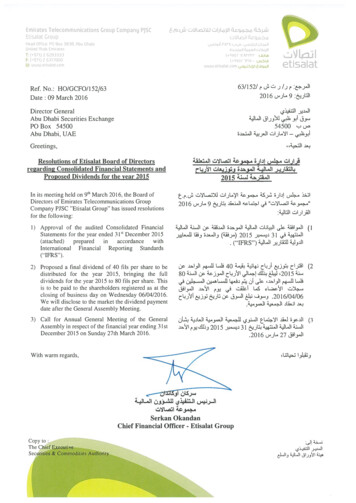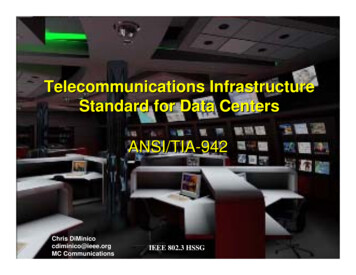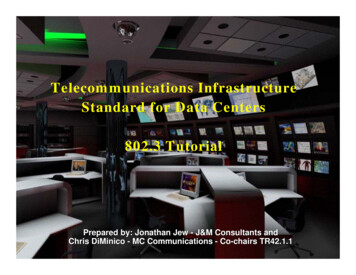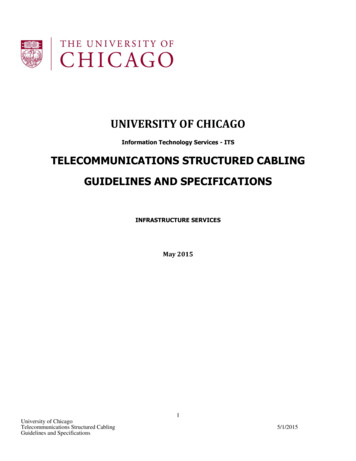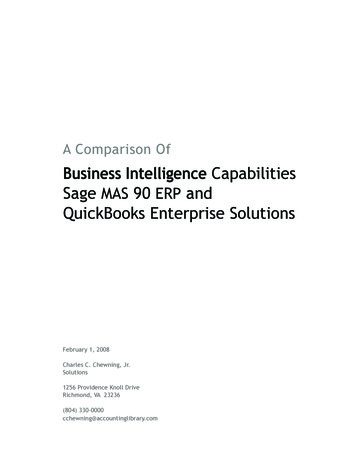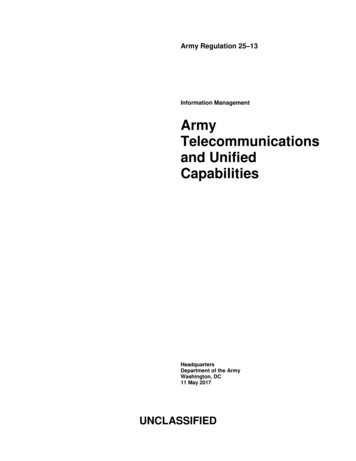
Transcription
Army Regulation 25–13Information ManagementArmyTelecommunicationsand UnifiedCapabilitiesHeadquartersDepartment of the ArmyWashington, DC11 May 2017UNCLASSIFIED
SUMMARY of CHANGEAR 25–13Army Telecommunications and Unified CapabilitiesThis major revision, dated 11 May 2017—oIncorporates responsibilities of U.S. Army Cyber Command as required by Headquarters, Department of the ArmyGeneral Order No. 2017–01. This general order established U.S. Army Cyber Command as a direct reporting unit ofthe Chief Information Officer/G-6. U.S. Army Network Enterprise Technology Command, formerly a directreporting unit of the Chief Information Officer/G–6, Headquarters, Department of the Army, is assigned to U.S.Army Cyber Command (throughout).oProvides guidance for the management of bandwidth utilization and the reduction and removal of nonessential (nonmission) data, voice, and video communications traffic in times of surge or crisis (para 3–5).oIncorporates guidance for the transition of services away from Integrated Services Digital Network equipment andtransport; and provides policy concerning the reduction and elimination of investment in Integrated Services DigitalNetwork supported technology (para 4–4).oIncorporates guidance and process for voice precedence (flash override, flash immediate, and priority) servicerequests and requirements submission (para 4–5a(5)).oProvides guidance for the management, reporting, and personnel accountability of video teleconferencing services(para 4–6).oProvides additional guidance on the procurement and use of next-generation Department of Defense wirelessservices and devices under wireless enterprise blanket purchase agreements in order to align with current policy; anddeletes the secure mobile environment portable electronic device (para 4–8c(1)).oReplaces “Global Information Grid waiver” references with “Department of Defense Information Network waiver”and provides additional guidance consistent with current Department of Defense Information Network waiverpolicy, process, and procedure; and provides additional guidance on the multiple type of waivers (para 6–3 andthroughout).oIncorporates guidance for the Unified Capabilities Approved Product List Removal List (para 7–3).oIncorporates guidance for unclassified and secret level voice services being provided by either Defense InformationSystems Agency or Army; and corrects Command, Control, Communications, Computers and InformationManagement services to two service categories (para 7–4).oIncorporates guidance for installation of Assured Service Local Area Network services (para 7–7).oIdentifies the web-based Army Information Technology Approval System as the replacement for the Goal 1 Waiversystem (throughout).
HeadquartersDepartment of the ArmyWashington, DC11 May 2017*Army Regulation 25–13Effective 11 June 2017Information ManagementArmy Telecommunications and Unified CapabilitiesStates, and the U.S. Army Reserve, unlessotherwise stated. Portions of this regulation prescribe specific prohibitions that arepunitive, and violations of these provisionsmay subject offenders to nonjudicial orjudicial action under the Uniform Code ofMilitary Justice. During mobilization,procedures in this publication can be modified to support policy changes as necessary.History. This publication is a majorrevision.Summary. This regulation establishespolicies and assigns responsibilities for themanagement of telecommunications andunified capabilities. It applies to information technology contained in businesssystems and national security systems(except as noted) developed for, or purchased by, the Department of the Army. Itimplements the provisions of Title 10,United States Code, Sections 2223 and3014; Title 40 United States Code, SubtitleIII, Clinger-Cohen Act; Title 44 UnitedStates Code, chapters 35 and 36; DODD8000.01; DODI 8100.04; DODD 5105.77;DODD 5105.83; and other related Federalstatutes and directives. The full scope ofChief Information Officer responsibilitiesand management processes for telecommunications and unified capabilities aredescribed throughout this regulation.cy, command, and installation forms areprohibited without prior approval from theChief Information Officer/G–6 (SAIS–PRU), 107 Army Pentagon, Washington,DC 20310–0107.Suggested improvements. Users areinvited to send comments and suggestedimprovements on DA Form 2028 (Recommended Changes to Publications andBlank Forms) directly to the Office of theProponent and exception authority. Chief Information Officer/G–6 (SAIS–The proponent of this regulation is the PRU), 107 Army Pentagon, Washington,Chief Information Officer/G–6. The pro- DC 20310–0107.ponent has the authority to approve exceptions or waivers to this regulation that are Committee management. AR 15–1consistent with controlling law and regula- requires the proponent to justify establishtions. The proponent may delegate this ing/continuing committee(s), coordinateapproval authority, in writing, to a division draft publications, and coordinate changeschief within the proponent agency or its in committee status with the Office of thedirect reporting unit or field operating Administrative Assistant to the Secretaryagency, in the grade of colonel, or the of the Army, Department of the Armycivilian equivalent, or above. Activities Committee Management Office (AARP–may request a waiver to this regulation by ZA), 9301 Chapek Road, Building 1458,providing justification that includes a full Fort Belvoir, VA 22060–5527. Further, ifanalysis of the expected benefits and must it is determined that an established “group”include formal review by the activity’s identified within this regulation, later takessenior legal officer. All waiver requests on the characteristics of a committee, aswill be endorsed by the commander or found in the AR 15–1, then the proponentsenior leader of the requesting activity and will follow all AR 15–1 requirements forforwarded through their higher headquar- establishing and continuing the group as aters to the policy proponent. Refer to AR committee.25–30 for specific guidance.Distribution. This regulation is availaArmy internal control process. This ble in electronic media only and is intendregulation contains internal control provi- ed for command levels A, B, C, D, and Esions in accordance with AR 11–2 and for the Active Army, the Army Nationalidentifies key internal controls that must be Guard/Army National Guard of the UnitedStates, and the U.S. Army Reserve.evaluated (see appendix C).Applicability. This regulation applies tothe Active Army, the Army National Supplementation. Supplementation ofGuard/Army National Guard of the United this regulation and establishment of agen-Contents (Listed by paragraph and page number)Chapter 1Introduction, page 1Purpose 1–1, page 1References 1–2, page 1*This regulation supersedes AR 25–13, dated 25 March 2013.AR 25–13 11 May 2017UNCLASSIFIEDi
Contents—ContinuedExplanation of abbreviations and terms 1–3, page 1Responsibilities 1–4, page 1Chapter 2Responsibilities, page 1Assistant Secretary of the Army for Acquisition, Logistics and Technology 2–1, page 1Chief Information Officer/G–6 2–2, page 1Chief, National Guard Bureau 2–3, page 2Chief, Army Reserve 2–4, page 3Chief, U.S. Army Corps of Engineers 2–5, page 3Commanders and activity heads of Army commands, Army service component commands, and direct reportingunits 2–6, page 3Chapter 3Utilization of telecommunications and unified capabilities, page 5Official uses of telecommunications and computing systems 3–1, page 5Unauthorized and prohibited uses of telecommunications and computing systems 3–2, page 6Communications monitoring and recording 3–3, page 6Leasing of Government-owned telecommunications assets 3–4, page 7Bandwidth utilization management (minimize) 3–5, page 7Information technology support for telework 3–6, page 8Military construction communication systems policy 3–7, page 8Architectures 3–8, page 8Chapter 4Telecommunications Systems and Services, page 8Applicability 4–1, page 8Time-division multiplex equipment 4–2, page 8Asynchronous transport mode equipment 4–3, page 9Integrated services digital networking 4–4, page 9Telephone systems 4–5, page 9Video services 4–6, page 11Commercial television service 4–7, page 12Multifunction mobile devices 4–8, page 13Wireless priority service and wireline government emergency telecommunications service 4–9, page 15Non-tactical radio systems 4–10, page 15Chapter 5Satellite Communication Systems and Position Navigation and Timing, page 16General 5–1, page 16Commercial satellite communication annual usage report 5–2, page 16Satellite communication requirements 5–3, page 16Use of wideband military satellite communications 5–4, page 17Satellite communication standardization 5–5, page 17Network command operations of military satellite communication systems 5–6, page 17Army component command to United States Strategic Command 5–7, page 17International Maritime Satellite and Iridium 5–8, page 17Position, navigation, and timing global positioning system, precise positioning service, and standard positioning services 5–9, page 18Chapter 6Long-Haul and Deployable Telecommunications, page 18General 6–1, page 18Mission partner and defense contractor connections to the Defense Information Systems Network 6–2, page 19Department of Defense Information Network waivers 6–3, page 20Military telecommunications agreements 6–4, page 21iiAR 25–13 11 May 2017
Contents—ContinuedChapter 7Unified Capabilities, page 22Introduction 7–1, page 22General 7–2, page 23Unified capabilities approved product list 7–3, page 23Voice services 7–4, page 23Video telecommunication services 7–5, page 25Collaboration capabilities 7–6, page 25Installation information infrastructure 7–7, page 26AppendixesA. References, page 27B. Telecommunications Services Authorized for Specific Activities, page 31C. Internal Control Evaluation, page 35GlossaryAR 25–13 11 May 2017iii
Chapter 1Introduction1–1. PurposeThis regulation establishes Department of the Army (DA) policies and assigns responsibilities for the management oftelecommunications and unified capabilities (UC). It implements the provisions of Title 10, United States Code (10USC) Sections 2223 and 3014; 40 USC Subtitle III, Clinger-Cohen Act; 44 USC 35; 44 USC 36; DODD 5105.77;DODD 5105.83; DODD 8000.01; DODI 8100.04; and other related Federal statutes and directives. For Army tenantunits residing on non-Army hosted installations or Joint bases, some local processes may vary from this regulation.Guidance and direction from this regulation will be used as the basis for input to local or Joint memorandums of agreement.1–2. ReferencesSee appendix A.1–3. Explanation of abbreviations and termsSee the glossary.1–4. ResponsibilitiesSee chapter 2.Chapter 2Responsibilities2–1. Assistant Secretary of the Army for Acquisition, Logistics and TechnologyThe ASA (AL&T) will —a. Monitor and account for equipment from production to transfer onto appropriate command accounts (from production to in-service, or to in-storage/inventory). Commands will maintain and account for physical inventory of UC andtelecommunications equipment.b. Assist the Chief Information Officer (CIO)/G–6, using an engineering-based approach, to determine current and future bandwidth requirements for circuits that connect installations to the Department of Defense Information Network(DODIN).2–2. Chief Information Officer/G–6The CIO/G–6 is the senior Army authority for telecommunications and UC. The CIO/G–6 will —a. Serve as senior Army authority for Joint Staff-controlled mobile and transportable telecommunications assets.b. Oversee the Army Spectrum Management program. This includes the coordination and use of radio frequency resources within the United States and its possessions and the registration and processing of spectrum-dependent systemsthrough the Army Spectrum Certification Program.c. Advise the planning, programming, budgeting, and executing of resources to support enterprise-level telecommunications and network services, such as the Defense Information Systems Network (DISN) Subscription Service.d. Integrate policy, oversight, and guidance to achieve Army communications objectives in the Army information environment.e. Review and provide subject matter expertise on information technology (IT), telecommunications, and UC unfunded requirements submitted by commands to CIO/G–6 for potential procurement funding.f. Generate requirements for enterprise-wide telecommunications and UC services.g. Provide the appropriate level representative to the following working groups, forums, and boards:(1) Participant and voting member of the Military Communications-Electronics Board.(2) Participant and voting member of the DOD Unified Capabilities Steering Group.(3) Participant and voting member in the Defense Information Assurance Security Accreditation Working Group(DSAWG), reference the DSAWG home page at rpriseconnections/dsawg.(4) Participant and voting member in the Defense Information Systems Agency (DISA) Customer Forum.(5) Participant and voting member of the DOD Interoperability Steering Group.AR 25–13 11 May 20171
(6) Serve as the Army voting member of the Satellite Communications (SATCOM) Gateway Configuration ControlWorking Group.(7) Participant in the DOD Unified Capabilities Industry Advisory Council.h. Delegate to Commander, U.S. Army Cyber Command (USARCYBER) all infrastructure management activities,tactics, processes, procedures, and protocols for the management of infrastructure assets such as Army networks, UC,telecommunications, installation facilities, data storage, IT services continuity, and mid-range and mainframe computing.Commander, USARCYBER will —(1) Prescribe security of telecommunications and UC for assigned fixed-station communicatio
Refer to AR 25–30 for specific guidance. Army internal control process . This regulation contains internal control provi-sions in accordance with AR 112 and – identifies key internal controls that must be evaluated (see . appendix C). Supplementation. Supplementation of this regulation and establishment of agen-cy, command, and installation forms are prohibited without prior approval from .
